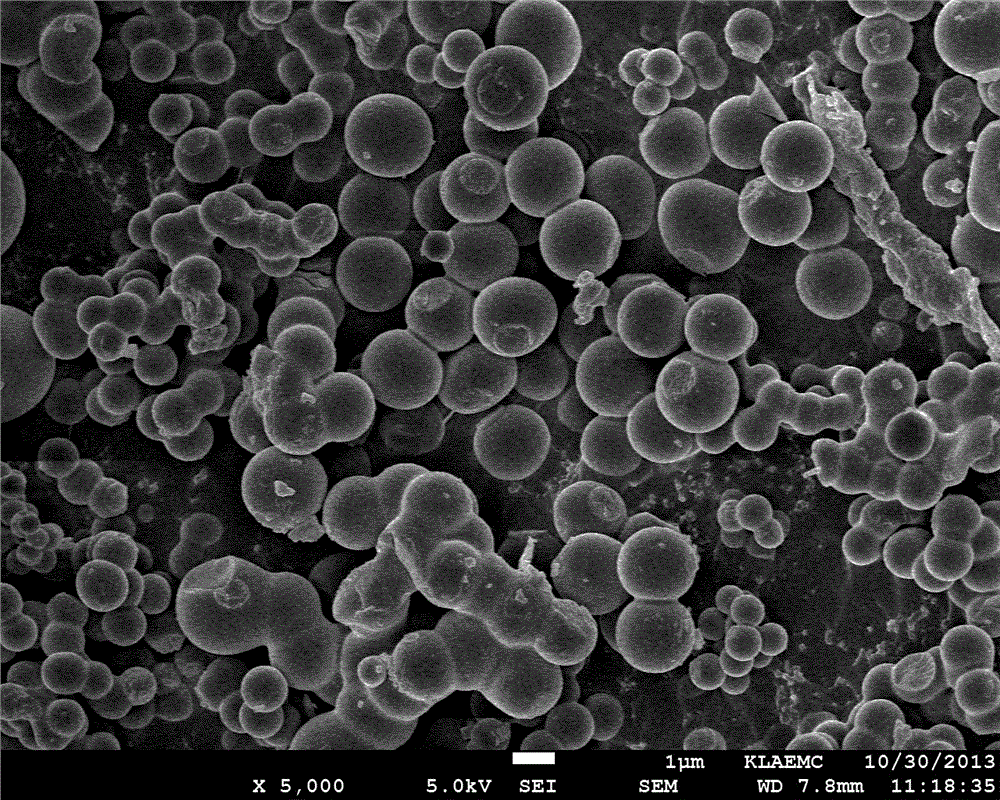One-step hydrothermal synthesis of carbon microspheres solid acid from fructose for catalyzing cellulose hydrolysis
A sugar-based carbon microsphere, cellulose technology, applied in the direction of physical/chemical process catalyst, application, sugar production, etc., can solve the problems of pollution, a large amount of waste gas environment, etc., and achieve a simple process, low temperature and mild reaction conditions. Effect
- Summary
- Abstract
- Description
- Claims
- Application Information
AI Technical Summary
Problems solved by technology
Method used
Image
Examples
Embodiment 1
[0025] Embodiment 1, preparation and characterization of the invented catalyst:
[0026] The preparation process of the carbon microsphere solid acid catalyst is summarized as follows: 10 g of fructose, 5 g of sulfo-salicylic acid and 60 ml of distilled water were successively added under magnetic stirring, and the stirring was continued for 30 min. Then the mixed solution was transferred into a 100ml stainless steel autoclave lined with polytetrafluoroethylene, sealed and heated to a constant temperature of 150°C for 4 hours, and stirred at a speed of 1000 rpm. After the reaction, the reactor was cooled to room temperature. The resulting black powder was alternately washed with distilled water and ethanol several times (ten times in total, 6 times with water and 4 times with alcohol), and dried at a constant temperature of 80°C for 12 hours to remove all the water to obtain a carbon microsphere solid acid catalyst. The catalyst is characterized by SEM, FT-IR, XRD and element...
Embodiment 2
[0027] Embodiment 2, preparation and characterization of the invented catalyst:
[0028] The preparation process of the carbon microsphere solid acid catalyst is summarized as follows: 10 g of fructose, 10 g of sulfo-salicylic acid and 60 ml of distilled water were successively added under magnetic stirring, and the stirring was continued for 30 min. Then the mixed solution was transferred into a 100ml stainless steel autoclave lined with polytetrafluoroethylene, sealed and heated to a constant temperature of 150°C for 4 hours, and stirred at a speed of 1000 rpm. After the reaction, the reactor was cooled to room temperature. The resulting black powder was alternately washed with distilled water and ethanol several times (ten times in total, 6 times with water and 4 times with alcohol), and dried at a constant temperature of 80°C for 12 hours to remove all the water to obtain a carbon microsphere solid acid catalyst. The catalyst is characterized by SEM, FT-IR, XRD and elemen...
Embodiment 3
[0029] Embodiment 3, the new catalytic process of cellulose hydrolysis:
[0030] Add 0.05g of cellulose and 1g of 1-butyl-3-methylimidazolium chloride salt ionic liquid into a 10ml reactor, dissolve the cellulose at 80°C, then add 0.01g of water and 0.05g of the catalyst synthesized in the present invention , heated to 130°C in a sealed state, reacted for 90 minutes, and then cooled rapidly with an ice-water bath; after taking out the reaction solution and diluting it, the yield of reducing sugar was measured by 3,5-dinitrosalicylic acid method (DNS) to be 62% .
PUM
| Property | Measurement | Unit |
|---|---|---|
| diameter | aaaaa | aaaaa |
| diameter | aaaaa | aaaaa |
Abstract
Description
Claims
Application Information
 Login to View More
Login to View More - R&D
- Intellectual Property
- Life Sciences
- Materials
- Tech Scout
- Unparalleled Data Quality
- Higher Quality Content
- 60% Fewer Hallucinations
Browse by: Latest US Patents, China's latest patents, Technical Efficacy Thesaurus, Application Domain, Technology Topic, Popular Technical Reports.
© 2025 PatSnap. All rights reserved.Legal|Privacy policy|Modern Slavery Act Transparency Statement|Sitemap|About US| Contact US: help@patsnap.com

